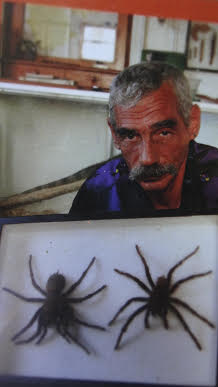
Avicularia is a genus of the family Theraphosidae containing various species of arboreal tarantulas. The genus is native to Panama, the Caribbean, and tropical South America. Each species in the genus has very distinguishable pink foot pads.

Previously placed in the genus Avicularia, C. versicolor is native to Martinique in the Caribbean Sea.
Euathlus affinis is a species of spider belonging to the family Theraphosidae (tarantulas). It is native to Chile.

Tarantulas comprise a group of large and often hairy spiders of the family Theraphosidae. As of December 2023, 1,100 species have been identified, with 166 genera. The term "tarantula" is usually used to describe members of the family Theraphosidae, although many other members of the same infraorder (Mygalomorphae) are commonly referred to as "tarantulas" or "false tarantulas". Some of the more common species have become popular in the exotic pet trade. Many New World species kept as pets have setae known as urticating hairs that can cause irritation to the skin, and in extreme cases, cause damage to the eyes.
Grammostola anthracina is a species of spider belonging to the family Theraphosidae (tarantulas). It is found in Uruguay, Paraguay, Brazil, and Argentina.

Theraphosa apophysis is a species of spider in the family Theraphosidae, found in Venezuela, Colombia and Brazil.

The skeleton tarantula, Ephebopus murinus, is a species of spider belonging to the family Theraphosidae (tarantulas), sub-family Aviculariinae. A New World species, it is native to several South American countries. Its common name is derived from the skeleton-like markings on its legs.

The Aviculariinae are a subfamily of spiders in the family Theraphosidae (tarantulas). They can be distinguished from other theraphosids by a number of characters. Their legs have no or few spines on the underside of the tibial and metatarsal joints of the legs. The last two leg joints have brushes of hairs (scopulae) that extend sideways, particularly on the front legs, giving them a spoon-like (spatulate) appearance. Females have two completely separated spermathecae.

Antillena is a genus of spiders in the family Theraphosidae (tarantulas). As of March 2017, the genus contained a single species, Antillena rickwesti, found in the Dominican Republic.

Caribena is a genus of spiders in the family Theraphosidae (tarantulas), found in the Antilles. The two species accepted as of March 2017 were formerly placed in Avicularia. Apart from a different distribution – Avicularia species are found in mainland South and Central America – Caribena is distinguished by having longer and thinner type II urticating hairs in a conspicuous patch on the upper surface of the abdomen. Males also have a differently shaped palpal bulb.

Ybyrapora is a genus of spiders in the family Theraphosidae (tarantulas), found in Brazil. Its species were formerly placed in the genus Avicularia.

Avicularia juruensis is a species of spider in the family Theraphosidae, found in South America. Avicularia urticans was brought into synonymy in 2017. It has been given the English name Amazonian pink toe spider. Under the synonym Avicularia urticans, it is also known as the Peruvian pinktoe tarantula. It is a large mygalomorph spider, with a maximum body length over 30 mm (1.2 in) and the longest fully extended leg about 60 mm (2.4 in). Like other species in the genus Avicularia, specimens under this name are sold as pets, although their identity has not been confirmed by taxonomic studies.

Avicularia rufa is a species of spider in the family Theraphosidae. Specimens from the Brazilian states of Mato Grosso and Rondônia have regularly been misidentified as Avicularia juruensis. One difference is the vivid yellow rings on the legs of A. rufa compared to the paler rings of A. juruensis.

Avicularia lynnae is a species of spiders in the family Theraphosidae, found in Ecuador and Peru. It was first described in 2017. The specific name refers to Lynn West, wife of mygalomorph expert Rick C. West.

Avicularia caei is a species of spiders in the family Theraphosidae found in Brazil. It was first described in 2017. The specific name honours Carlos Eduardo Gurgel Paiola, known as "Caê".

Avicularia merianae is a species of spiders in the family Theraphosidae, found in Peru. It was first described in 2017. It is named after the Dutch-German naturalist and painter Maria Sibylla Merian, in recognition of her studies on tarantulas.

Avicularia minatrix also known as the Red Slate Pink Toe, Redstripe Pinktoe or Venezuelan Redstripe Tarantula is a species of spider in the family Theraphosidae, found in Venezuela and Brazil. It was first described by Reginald Innes Pocock in 1903, being arboreal in nature and quite reclusive, and also the smallest tarantula of the Avicularia genus.
Avicularia glauca is a species of spider in the family Theraphosidae, found in Panama. The species was first described by Eugène Simon in 1891. As of March 2017, only a single female preserved specimen is known. It appears to be closely related to Avicularia purpurea. Avicularia species are rare in southern Central America; further studies are in progress.

Caribena laeta is a species of spider in the family Theraphosidae, found in the US Virgin Islands, Puerto Rico, and Cuba, the last dubiously according to Caroline Fukushima and Rogério Bertani in 2017. It was first described by Carl Ludwig Koch in 1842 under the name Mygale laeta.

Ybyrapora sooretama is a species of spider in the family Theraphosidae, found in Brazil.


















